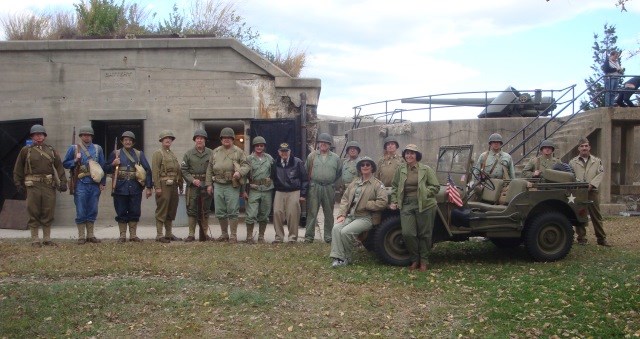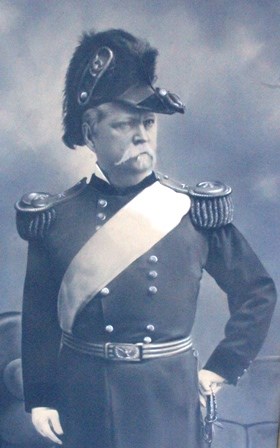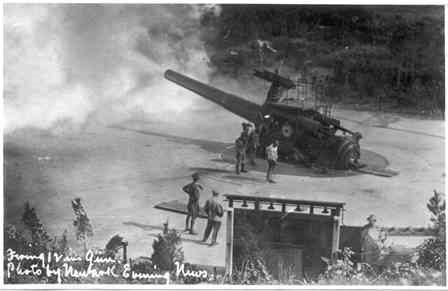
Photo by the Army Ground Forces Association (AGFA) The people behind the names Who was the "Hancock" in Fort Hancock? Why do gun batteries have names like Arrowsmith, Mills and Peck? Why is one Sandy Hook beach referred to as Gunnison Beach? Naming batteries was a nationally significant action. Names were ultimately chosen by the Secretary of War, often with input from members of Congress. The U.S. Army named Fort Hancock and its batteries after Army officers in honor of their service, especially those who died in the line of duty. While few of the batteries were named after men who actually served at Fort Hancock, their names held meaning and inspiration to the soldiers who served here. 
NPS PHOTO By Bob Hillman Winfield Scott Hancock (1824-1886): Perhaps his name inspired his deeds. Winfield Scott Hancock was named after General Winfield Scott, best known for his service in the War of 1812 and as an unsuccessful presidential candidate in 1852. Hancock served with distinction in battle during the war with Mexico. He earned even greater fame during the Civil War, when he was ultimately promoted to major general. After his exceptional handling of his troops at the Battle of Williamsburg, Union Commander George McClellan called him "Hancock the Superb" ---the highest complement one officer could give another. On each of the three days in the Battle of Gettysburg, Hancock's leadership and decisions helped secure the Union victory despite being severely wounded himself. When President Lincoln was assassinated, he supervised the execution of those convicted in the conspiracy. Like the man he was named after, Hancock would come close to trading his military career for the presidency, but would fall short. After the Civil War, his role as the general in charge of the military district covering Texas and Louisiana pleased former Confederates but not those who favored greater protections for newly-freed citizens. After some time in the Dakotas under President Grant, Hancock assumed command of the Department of the East in 1877, with headquarters at Fort Jay on Governors Island. In 1880 he ran for president as the Democratic nominee against another former Union army general, Republican candidate James A. Garfield. The popular vote was extremely close. Out of nine million ballots cast, Garfield won only 7,000 votes more than Hancock. But presidential elections are decided by the vote in the Electoral College, where Garfield won handily, 214 to 155. Still in command of the Military Division of the Atlantic, he died at Governors Island in 1886. For more about Winfield Scott Hancock, see the Civil War Trust bio or any number of other web entries about his life. 
George Arrowsmith (1839-1863), local hero Battery Arrowsmith was named after Lieutenant Colonel George W. Arrowsmith (1839-1863), a native of Middletown Township, New Jersey where Fort Hancock is located (despite sharing a zip code with nearby Highlands). Arrowsmith was ill when he and his regiment marched to Gettysburg to assist on the first day of battle, but he insisted on remaining with his soldiers. "I have come to feel that the bullet has not been molded [made] that can kill me," he told his troops. Unfortunately, he was wrong. The response to Arrowsmith's death is a remarkable testimony to his short life. After his death in battle, Arrowsmith's brother took the long, arduous trip to Gettysburg during wartime to locate and retrieve his remains. He is buried in the family plot in Middletown. Even decades after his death, local veterans remembered his sacrifice. During the battery's construction in 1908, when it was equipped with three 8-inch M1888 guns on disappearing carriages, local Civil War veterans petitioned the Secretary of War to name the new structure after Arrowsmith. 
NPS ARCHIVES Other batteries and the men they were named after Battery Gunnison (and, since it is close by, Gunnison Beach) was built with two 6-inch M1903 guns on disappearing carriages. It was named after John Williams Gunnison (1812-1853). He explored the Great Lakes region for the Army and surveyed many areas, including the border between Wisconsin and Michigan. While scouting in Utah for the Army in 1853, Gunnison died during an attack. The Army redesignated the fortification as New Battery Peck during World War II after two 6-inch guns and pedestal mounted carriages were moved from the original Battery Peck (below) to this location. (That's why there is a space below the word Battery on the top photo, where the name John Gunnison was removed by the Army.) Battery Archibald H. Engle was built for one 5-inch M1900 barbette gun. It named after a captain in the 13th U.S. Infantry who was killed in the battle of Resaca, Georgia on May 14, 1864. Battery Granger was a reinforced concrete Endicott Period 10-inch coastal gun battery named after Major General Gordon Granger, who distinguished himself in the Mexican War and the Civil War. Battery Kingman, built during World War I of reinforced concrete and hosted a 12-inch M1895 long range barbette carriage, was named after Brigadier General Dan C. Kingman (1852-1916). Kingman commanded the U.S. Army Corps of Engineers to design a barbette carriage that increased the range of Coastal Artillery guns. This new type of gun carriage could match the new expanded firing range of guns on foreign vessels. The battery at Sandy Hook, which housed guns with the new carriages, was in design when Kingman died, so it was named in his honor. Battery McCook was the northern half of what was originally called Sandy Hook Mortar Battery No. 1. It was renamed in 1906 after Major General Alexander McCook (1831-1903), who fought bravely during the Civil War. His father and seven brothers, plus five cousins, fought in the war. Collectively they were called "the fighting McCooks." The other half of the battery was named Battery Reynolds, below. Battery Mills, a reinforced concrete World War I period 12-inch M1895 long range barbette carriage coast defense battery, stood just to the south of Battery Kingman. It was identical to Kingman in design and layout. It was named after Major General Albert Leopold Mills (1854-1916), who received the Medal of Honor for bravery during the Battle of San Juan Hill during the Spanish-American War. The 1942 Site Plan tells more about both batteries Kingman and Mills. Battery Lewis Morris was a colonel in the 7th New York Volunteer Artillery who was killed at the Battle of Cold Harbor in 1864. Battery Peck, a reinforced concrete Endicott Period six-inch gun battery, was named after 1st Lieutenant Fremont P. Peck (1866-1895). Stationed at the Sandy Hook Proving Ground, Peck was killed here on February 19, 1895 when an experimental gun burst while being test-fired. When Peck's guns moved to the former Battery Gunnison during World War II, Peck was renamed the rather prosaic Anti-Motor Torpedo Boat Battery #8. Battery Potter, built with two M1888 12-inch rifles, was the first and only steam powered hydraulic lift gun battery built in the United States. It was named after Brigadier General Joseph H. Potter (1822-1892). He served in the Mexican War and the Civil War, where he was cited for gallant and meritorious service for the battle of Fredericksburg and the battle of Chancellorsville, where he was severely wounded. Potter was chief of staff for the Union Army's XXIV Corps during the final campaign that led to the surrender of Robert E. Lee's Confederate Army at Appomattox Court House, Virginia. Battery Potter became the Harbor Entrance Control Post during World War II. Battery Reynolds, a reinforced concrete Endicott Period sixteen gun 12-inch coast defense mortar battery, was named after Colonel John F. Reynolds (1820-1863), killed at the Battle of Gettysburg. (Hancock, above, was his replacement in battle.) Batteries McCook-Reynolds became the Harbor Defense Command Post during World War II. Battery Thomas D. Urmston, built with six 3-inch M1903 coast defense guns, was named after the brevet captain of the 12th U.S. Infantry who was killed in action at Chapel House, Virginia on October 1, 1864. Within Nine-Gun Battery: * Battery William Alexander, sporting two 12-inch M1888 coast defense guns on disappearing carriages, was named after Revolutionary War Major General Alexander, better known as Lord Stirling (a Scottish title). * Battery Joseph Bloomfield, built with two 12-inch M1895 coast defense guns on disappearing carriages, was named after a brigadier general who served in both the American Revolution and the War of 1812. * Battery Henry W. Halleck, built with three 10-inch M1888 coast defense guns on disappearing carriages, was named after the Civil War major general who served as commander-in-chief of the U.S. Army from 1862 to 1864. * Battery Israel Richardson, built with two 12-inch M1900 coast defense guns on disappearing carriages, was named after a major general who died of his wounds in the Battle of Antietam. Dig deeper Check out the FortWiki entry for Fort Hancock and the website's pages on specific batteries located here, along with photos and much greater detail as to how each battery was used by the Army. |
Last updated: May 17, 2018
